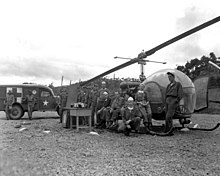
Back MASH Czech Mobile Army Surgical Hospital German MASH (hospital móvil quirúrgico del ejército) Spanish 육군이동외과병원 Korean Mobile Army Surgical Hospital NB Mobilny wojskowy szpital chirurgiczny Polish Mobile Army Surgical Hospital SIMPLE Mobile Army Surgical Hospital Swedish Мобільний армійський хірургічний шпиталь Ukrainian
This article needs additional citations for verification. (February 2011) |

Mobile Army Surgical Hospitals (MASH) were U.S. Army field hospital units conceptualized in 1946 as replacements for the obsolete World War II-era Auxiliary Surgical Group hospital units.[1] MASH units were in operation from the Korean War to the Gulf War before being phased out in the early 2000s, in favor of combat support hospitals.[1][2]
Each MASH unit had 60 beds, as well as surgical, nursing, and other enlisted and officer staff available at all times.[1] MASH units filled a vital role in military medicine by providing support to army units upwards of 10,000 to 20,000 soldiers.[3] These units had a low mortality rate compared to others, as the transportation time to hospitals was shorter, resulting in fewer patients dying within the "Golden Hour",[4] the first hour after an injury is first sustained, which is referred to in trauma as the "most important hour".[4] The U.S. Army deactivated the last MASH unit on February 16, 2006.
- ^ a b c "Mobile army surgical hospital". www.britannica.com. Retrieved 2021-11-18.
- ^ "Goodbye, farewell and amen to the last US Mash unit". The Guardian. 2006-02-07. Retrieved 2021-11-18.
- ^ "Masthead". Journal of the National Medical Association. 101 (2): 97. February 2009. doi:10.1016/s0027-9684(15)30816-6. ISSN 0027-9684.
- ^ a b Karras, D. J. (2006-05-01). "Emergency Medicine Research Directors: Society for Academic Emergency Medicine 2005 Survey Results". Academic Emergency Medicine. 13 (5Supplement 1): S202 – S203. doi:10.1197/j.aem.2006.03.515. ISSN 1069-6563.